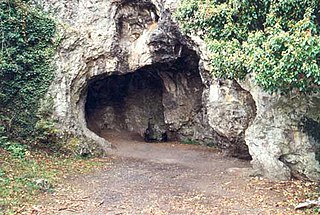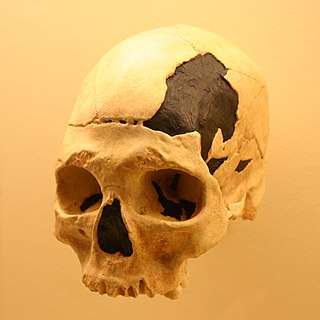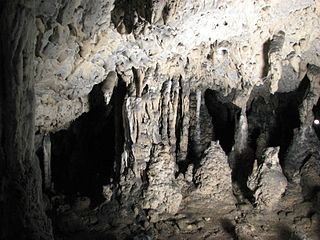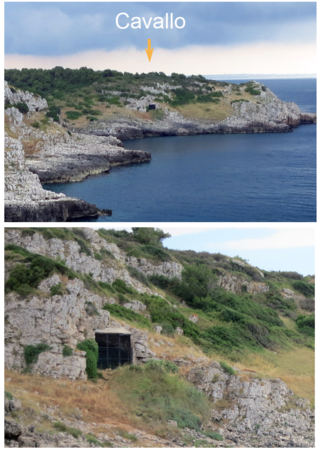Related Research Articles

The Red "Lady" of Paviland is an Upper Paleolithic partial male skeleton dyed in red ochre and buried in Wales 33,000 BP. The bones were discovered in 1823 by William Buckland in an archaeological dig at Goat's Hole Cave which is a limestone cave between Port Eynon and Rhossili on the Gower Peninsula, near Swansea in south Wales. Buckland believed the skeleton was a Roman era female. Later, William Solace examined Goat's Cave Paviland in 1912. There, Solace found flint arrow heads and tools and correctly concluded that the skeleton was in fact a male hunter-gatherer or warrior during the last Ice Age.
The Research Laboratory for Archaeology and the History of Art (RLAHA) is a laboratory at the University of Oxford, England which develops and applies scientific methods to the study of the past. It was established in 1955 and its first director was Teddy Hall. The first deputy director was Dr Stuart Young, who was followed by Martin Aitken in 1957. After many years of de facto association with the Institute of Archaeology, in 2000 it was jointly brought under the single departmental umbrella of School of Archaeology.

Kents Cavern is a cave system in Torquay, Devon, England. It is notable both for its archaeological and geological features. The cave system is open to the public and has been a geological Site of Special Scientific Interest since 1952 and a Scheduled Ancient Monument since 1957.
The Châtelperronian is a proposed industry of the Upper Palaeolithic, the existence of which is debated. It represents both the only Upper Palaeolithic industry made by Neanderthals and the earliest Upper Palaeolithic industry in central and southwestern France, as well as in northern Spain. It derives its name from Châtelperron, the French village closest to the type site, the cave La Grotte des Fées.

The Upper Paleolithic is the third and last subdivision of the Paleolithic or Old Stone Age. Very broadly, it dates to between 50,000 and 12,000 years ago, according to some theories coinciding with the appearance of behavioral modernity in early modern humans. It is followed by the Mesolithic.

Spy Cave is located in Wallonia near Spy in the municipality of Jemeppe-sur-Sambre, Namur Province, Belgium above the left bank of the Orneau River. Classified as a premier Heritage site of the Walloon Region, the location ranks among the most significant paleolithic sites in Europe. The cave consists of numerous small chambers and corridors.

Prehistoric Wales in terms of human settlements covers the period from about 230,000 years ago, the date attributed to the earliest human remains found in what is now Wales, to the year AD 48 when the Roman army began a military campaign against one of the Welsh tribes. Traditionally, historians have believed that successive waves of immigrants brought different cultures into the area, largely replacing the previous inhabitants, with the last wave of immigrants being the Celts. However, studies of population genetics now suggest that this may not be true, and that immigration was on a smaller scale.

Peștera cu Oase is a system of 12 karstic galleries and chambers located near the city Anina, in the Caraș-Severin county, southwestern Romania, where some of the oldest European early modern human (EEMH) remains, between 42,000 and 37,000 years old, have been found.

Peștera Muierilor, or Peștera Muierii, is an elaborate cave system located in the Baia de Fier commune, Gorj County, Romania. It contains abundant cave bear remains, as well as a human skull. The skull is radiocarbon dated to 30,150 ± 800, indication an absolute age between 40,000 and 30,000 BP. It was uncovered in 1952. Alongside similar remains found in Cioclovina Cave, they are among the most ancient early modern humans in Romanian prehistory.

The Grotte du Renne is one of the many caves at Arcy-sur-Cure in France, an archaeological site of the Middle/Upper Paleolithic period in the Yonne departement, Bourgogne-Franche-Comté. It contains Châtelperronian lithic industry and Neanderthal remains. Grotte du Renne has been argued to provide the best evidence that Neanderthals developed aspects of modern behaviour before contact with modern humans, but this has been challenged by radiological dates, which suggest mixing of later human artifacts with Neanderthal remains. However, it has also been argued that the radiometric dates have been affected by post-recovery contamination, and statistical testing suggests the association between Neanderthal remains, Châtelperronian artefacts and personal ornaments is genuine, not the result of post-depositional processes.
During regular archaeological excavations, several flutes that date to the European Upper Paleolithic were discovered in caves in the Swabian Alb region of Germany. Dated and tested independently by two laboratories, in England and Germany, the artifacts are authentic products of the Aurignacian archaeological culture. The Aurignacian flutes were created between 43,000 and 35,000 years ago. The flutes, made of bone and ivory, represent the earliest known musical instruments and provide unmistakable evidence of prehistoric music.

Vindija Cave is an archaeological site associated with Neanderthals and modern humans, located in the municipality of Donja Voća, northern Croatia. Remains of three Neanderthals were selected as the primary sources for the first draft sequence of the Neanderthal genome project in 2010. Additional research was done on the samples and published in 2017.
Christopher Bronk Ramsey is a British physicist, mathematician and specialist in radiocarbon dating. He is a professor at the University of Oxford and was the Director of the Research Laboratory for Archaeology and the History of Art (RLAHA) from 2014 until 2019. He is a member of Merton College, Oxford and a Bodley Fellow. His doctorate, completed in 1987, included the first successful implementation of carbon dioxide gas as a target for radiocarbon dating via accelerator mass spectrometry.
The Kents Cavern 4 maxilla is a human fossil consisting of a right canine, third premolar, and first molar as well as the bone holding them together including a small piece of palate. The fossil was found in 1927 at Kents Cavern, a limestone cave in Torquay, Devon, England. The maxilla was uncovered at a depth of 10 feet 6 inches (3.20 m) and was located directly beneath a key ‘granular stalagmite’ at the site, which was used as a datum during excavations undertaken between 1926 and 1941 by the Torquay Natural History Society. The discovery of the KC4 maxilla was important because it became the earliest direct dated anatomically modern human (AMH) fossil yet discovered from a northwestern European site. Moreover the date obtained via a Bayesian statistical-modelling method provides evidence for the coexistence of anatomically modern humans and Neanderthals.

The Grotta del Cavallo or Cavallo Cave is a limestone cave in the region of Apulia, Southern Italy, near Nardò 90 km (55.92 mi) south of Taranto. The cave is about 15 m (49 ft) above present sea level. It has a rounded entrance, 5 m (16.40 ft) wide and 2.5 m (8.20 ft) high opening toward the sea. The cave was rediscovered in 1960 and two waves of excavations ensued. The first wave spanning from 1963 to 1966 and the second from 1986 to 2008. The cave was disturbed by looters during the period between the two waves of excavations, damaging the layers corresponding to the Upper Palaeolithic; because of this, the cave entrance is covered by a gate and is closed to the public.

Denny is an ~90,000 year old fossil specimen belonging to a ~13-year-old Neanderthal-Denisovan hybrid girl. To date, she is the only first-generation hybrid hominin ever discovered. Denny’s remains consist of a single fossilized fragment of a long bone discovered among over 2,000 visually unidentifiable fragments excavated at the Denisova Cave in the Altai Mountains, Russia in 2012.
Katerina Douka is an archaeological scientist whose work focuses on the spatio-temporal pattern of human dispersals and extinctions across Eurasia, including Neanderthals, Denisovans and modern Homo sapiens.
Rachel Wood is a specialist in the radiocarbon dating of Pleistocene archaeological sites. She is Director of the Oxford Radiocarbon Accelerator Unit (ORAU) at the University of Oxford.
Roger Michael Jacobi was a British archaeologist specialising in Palaeolithic and Mesolithic Britain. Known for his encyclopaedic knowledge of British prehistory, Jacobi authored several key synthetic volumes and worked to catalogue, sequence and reanalyse collections from across Britain and northwestern Europe. Sections of his extensive personal archive were posthumously published as the Palaeolithic and Mesolithic Artefact (PaMELA) database. He studied archaeology at Jesus College, Cambridge, and held positions at Lancaster University, the University of Nottingham, and the British Museum.

Archaeometry is a peer-reviewed academic journal covering archaeological science, particularly absolute dating methods, artefact studies, quantitative archaeology, remote sensing, conservation science, and environmental archaeology. It is published bimonthly by Wiley-Blackwell, on behalf of the Research Laboratory for Archaeology and the History of Art at the University of Oxford, in association with the Gesellschaft für Naturwissenschaftliche Archäologie Archäometrie and the Society for Archaeological Sciences. Its current editors are A. Mark Pollard, Ina Reiche, Brandi MacDonald, Gilberto Artioli, and Catherine Batt.
References
- ↑ Higham, Tom (2021). The World Before Us. Penguin Random House UK. p. 100. ISBN 9780241989050.
- ↑ Callaway, Ewen (2012). "Date with history". Nature. 485 (7396): 27–29. doi: 10.1038/485027a . PMID 22552075.
- ↑ "Uni Vienna: Archaeological Science as Game-Changer: What ancient genes tell us about who we are". LISAvienna Life Science Vienna. Austria Wirtschaftsservice/Vienna Business Agency. 2 June 2022. Retrieved 13 September 2023.
- ↑ "Latest News » Otago Boys' High School". obhs.school.nz. Retrieved 20 September 2022.
- ↑ Higham, Thomas (1993). Radiocarbon dating the prehistory of New Zealand (Unpublished PhD thesis). University of Waikato.
- ↑ "Professor Tom Higham". Keble College . Retrieved 25 February 2018.
- ↑ Wilmshurst, JM; Anderson, AJ; Higham, TFG; Worthy, TH (2008). "Dating the late prehistoric dispersal of Polynesians to New Zealand using the commensal Pacific rat". Proceedings of the National Academy of Sciences. 105 (22): 7676–7680. Bibcode:2008PNAS..105.7676W. doi: 10.1073/pnas.0801507105 . PMC 2409139 . PMID 18523023.
- ↑ Hogg, AG; Higham, TFG; Lowe, DJ; Palmer, JG; Reimer, PJ; Newnham, RM (2003). "A wiggle-match date for Polynesian settlement of New Zealand". Antiquity. 27 (295): 116–125. doi:10.1017/S0003598X00061408. hdl: 10289/5248 . S2CID 55072957.
- ↑ Bronk Ramsey, Christopher; Higham, Thomas; Bowles, Angela; Hedges, Robert (2004). "Improvements to the pretreatment of bone at Oxford". Radiocarbon. 46 (1): 155–163. doi: 10.1017/S0033822200039473 .
- ↑ Jacobi, RM; Higham, TFG; Bronk Ramsey, C (2006). "AMS radiocarbon dating of Middle and Upper Palaeolithic bone in the British Isles: improved reliability using ultrafiltration". Journal of Quaternary Science. 21 (5): 557–573. Bibcode:2006JQS....21..557J. doi: 10.1002/jqs.1037 . S2CID 128613381.
- ↑ Higham, TFG; Jacobi, RM; Bronk Ramsey, C (2006). "AMS Radiocarbon Dating of Ancient Bone Using Ultrafiltration". Radiocarbon. 48 (2): 179–195. doi: 10.1017/S0033822200066388 .
- ↑ Jacobi, RM; Higham, TFG (2008). "The 'Red Lady' ages gracefully: new ultrafiltration AMS determinations from Paviland". Journal of Human Evolution. 55 (5): 898–907. doi:10.1016/j.jhevol.2008.08.007. PMID 18929395.
- ↑ Higham, T; et al. (2011). "The earliest evidence for anatomically modern humans in northwestern Europe". Nature. 479 (7374): 521–4. Bibcode:2011Natur.479..521H. doi:10.1038/nature10484. PMID 22048314. S2CID 4374023.
- ↑ Higham, TFG; et al. (2014). "The timing and spatiotemporal patterning of Neanderthal disappearance". Nature. 512 (7514): 306–309. Bibcode:2014Natur.512..306H. doi:10.1038/nature13621. hdl: 1885/75138 . PMID 25143113. S2CID 205239973.
- ↑ "PalaeoChron Project". PalaeoChron Project.
- ↑ Henriques, Martha (6 September 2017). "Vindija Cave wasn't where humans and Neanderthals had their fling after all". International Business Times UK. Retrieved 25 February 2018.
- ↑ Silva-Velazquez, Yuri (26 April 2017). "Relics researchers feature in new CNN series". Keble College. Archived from the original on 26 February 2018. Retrieved 25 February 2018.
{{cite news}}: CS1 maint: unfit URL (link) - ↑ "Centenary cohort of Fellows announced". Royal Society of New Zealand. 1 November 2018. Retrieved 21 November 2018.